Input interpretation

CH_3CH_2OH ethanol ⟶ H_2 hydrogen + CH_3CHO acetaldehyde
Balanced equation
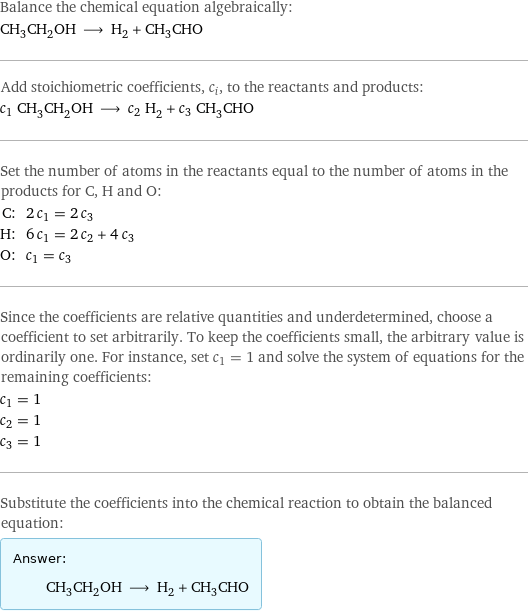
Balance the chemical equation algebraically: CH_3CH_2OH ⟶ H_2 + CH_3CHO Add stoichiometric coefficients, c_i, to the reactants and products: c_1 CH_3CH_2OH ⟶ c_2 H_2 + c_3 CH_3CHO Set the number of atoms in the reactants equal to the number of atoms in the products for C, H and O: C: | 2 c_1 = 2 c_3 H: | 6 c_1 = 2 c_2 + 4 c_3 O: | c_1 = c_3 Since the coefficients are relative quantities and underdetermined, choose a coefficient to set arbitrarily. To keep the coefficients small, the arbitrary value is ordinarily one. For instance, set c_1 = 1 and solve the system of equations for the remaining coefficients: c_1 = 1 c_2 = 1 c_3 = 1 Substitute the coefficients into the chemical reaction to obtain the balanced equation: Answer: | | CH_3CH_2OH ⟶ H_2 + CH_3CHO
Structures

⟶ +
Names

ethanol ⟶ hydrogen + acetaldehyde
Reaction thermodynamics
Enthalpy
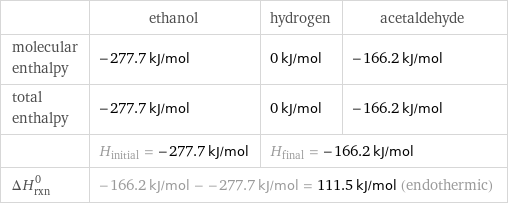
| ethanol | hydrogen | acetaldehyde molecular enthalpy | -277.7 kJ/mol | 0 kJ/mol | -166.2 kJ/mol total enthalpy | -277.7 kJ/mol | 0 kJ/mol | -166.2 kJ/mol | H_initial = -277.7 kJ/mol | H_final = -166.2 kJ/mol | ΔH_rxn^0 | -166.2 kJ/mol - -277.7 kJ/mol = 111.5 kJ/mol (endothermic) | |
Gibbs free energy
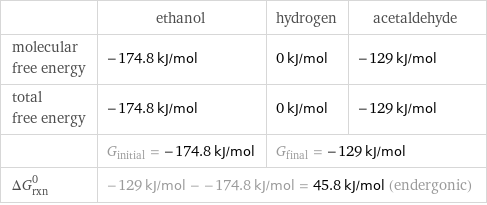
| ethanol | hydrogen | acetaldehyde molecular free energy | -174.8 kJ/mol | 0 kJ/mol | -129 kJ/mol total free energy | -174.8 kJ/mol | 0 kJ/mol | -129 kJ/mol | G_initial = -174.8 kJ/mol | G_final = -129 kJ/mol | ΔG_rxn^0 | -129 kJ/mol - -174.8 kJ/mol = 45.8 kJ/mol (endergonic) | |
Entropy
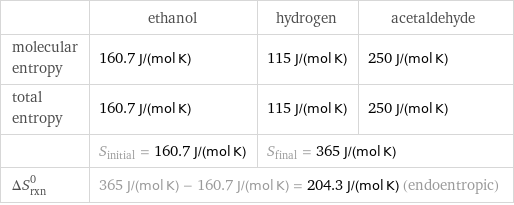
| ethanol | hydrogen | acetaldehyde molecular entropy | 160.7 J/(mol K) | 115 J/(mol K) | 250 J/(mol K) total entropy | 160.7 J/(mol K) | 115 J/(mol K) | 250 J/(mol K) | S_initial = 160.7 J/(mol K) | S_final = 365 J/(mol K) | ΔS_rxn^0 | 365 J/(mol K) - 160.7 J/(mol K) = 204.3 J/(mol K) (endoentropic) | |
Equilibrium constant
![Construct the equilibrium constant, K, expression for: CH_3CH_2OH ⟶ H_2 + CH_3CHO Plan: • Balance the chemical equation. • Determine the stoichiometric numbers. • Assemble the activity expression for each chemical species. • Use the activity expressions to build the equilibrium constant expression. Write the balanced chemical equation: CH_3CH_2OH ⟶ H_2 + CH_3CHO Assign stoichiometric numbers, ν_i, using the stoichiometric coefficients, c_i, from the balanced chemical equation in the following manner: ν_i = -c_i for reactants and ν_i = c_i for products: chemical species | c_i | ν_i CH_3CH_2OH | 1 | -1 H_2 | 1 | 1 CH_3CHO | 1 | 1 Assemble the activity expressions accounting for the state of matter and ν_i: chemical species | c_i | ν_i | activity expression CH_3CH_2OH | 1 | -1 | ([CH3CH2OH])^(-1) H_2 | 1 | 1 | [H2] CH_3CHO | 1 | 1 | [CH3CHO] The equilibrium constant symbol in the concentration basis is: K_c Mulitply the activity expressions to arrive at the K_c expression: Answer: | | K_c = ([CH3CH2OH])^(-1) [H2] [CH3CHO] = ([H2] [CH3CHO])/([CH3CH2OH])](../image_source/688cbecad00c3dd1b2434768de32cbde.png)
Construct the equilibrium constant, K, expression for: CH_3CH_2OH ⟶ H_2 + CH_3CHO Plan: • Balance the chemical equation. • Determine the stoichiometric numbers. • Assemble the activity expression for each chemical species. • Use the activity expressions to build the equilibrium constant expression. Write the balanced chemical equation: CH_3CH_2OH ⟶ H_2 + CH_3CHO Assign stoichiometric numbers, ν_i, using the stoichiometric coefficients, c_i, from the balanced chemical equation in the following manner: ν_i = -c_i for reactants and ν_i = c_i for products: chemical species | c_i | ν_i CH_3CH_2OH | 1 | -1 H_2 | 1 | 1 CH_3CHO | 1 | 1 Assemble the activity expressions accounting for the state of matter and ν_i: chemical species | c_i | ν_i | activity expression CH_3CH_2OH | 1 | -1 | ([CH3CH2OH])^(-1) H_2 | 1 | 1 | [H2] CH_3CHO | 1 | 1 | [CH3CHO] The equilibrium constant symbol in the concentration basis is: K_c Mulitply the activity expressions to arrive at the K_c expression: Answer: | | K_c = ([CH3CH2OH])^(-1) [H2] [CH3CHO] = ([H2] [CH3CHO])/([CH3CH2OH])
Rate of reaction
![Construct the rate of reaction expression for: CH_3CH_2OH ⟶ H_2 + CH_3CHO Plan: • Balance the chemical equation. • Determine the stoichiometric numbers. • Assemble the rate term for each chemical species. • Write the rate of reaction expression. Write the balanced chemical equation: CH_3CH_2OH ⟶ H_2 + CH_3CHO Assign stoichiometric numbers, ν_i, using the stoichiometric coefficients, c_i, from the balanced chemical equation in the following manner: ν_i = -c_i for reactants and ν_i = c_i for products: chemical species | c_i | ν_i CH_3CH_2OH | 1 | -1 H_2 | 1 | 1 CH_3CHO | 1 | 1 The rate term for each chemical species, B_i, is 1/ν_i(Δ[B_i])/(Δt) where [B_i] is the amount concentration and t is time: chemical species | c_i | ν_i | rate term CH_3CH_2OH | 1 | -1 | -(Δ[CH3CH2OH])/(Δt) H_2 | 1 | 1 | (Δ[H2])/(Δt) CH_3CHO | 1 | 1 | (Δ[CH3CHO])/(Δt) (for infinitesimal rate of change, replace Δ with d) Set the rate terms equal to each other to arrive at the rate expression: Answer: | | rate = -(Δ[CH3CH2OH])/(Δt) = (Δ[H2])/(Δt) = (Δ[CH3CHO])/(Δt) (assuming constant volume and no accumulation of intermediates or side products)](../image_source/e368f59ee22106b11be8ff2db30c3850.png)
Construct the rate of reaction expression for: CH_3CH_2OH ⟶ H_2 + CH_3CHO Plan: • Balance the chemical equation. • Determine the stoichiometric numbers. • Assemble the rate term for each chemical species. • Write the rate of reaction expression. Write the balanced chemical equation: CH_3CH_2OH ⟶ H_2 + CH_3CHO Assign stoichiometric numbers, ν_i, using the stoichiometric coefficients, c_i, from the balanced chemical equation in the following manner: ν_i = -c_i for reactants and ν_i = c_i for products: chemical species | c_i | ν_i CH_3CH_2OH | 1 | -1 H_2 | 1 | 1 CH_3CHO | 1 | 1 The rate term for each chemical species, B_i, is 1/ν_i(Δ[B_i])/(Δt) where [B_i] is the amount concentration and t is time: chemical species | c_i | ν_i | rate term CH_3CH_2OH | 1 | -1 | -(Δ[CH3CH2OH])/(Δt) H_2 | 1 | 1 | (Δ[H2])/(Δt) CH_3CHO | 1 | 1 | (Δ[CH3CHO])/(Δt) (for infinitesimal rate of change, replace Δ with d) Set the rate terms equal to each other to arrive at the rate expression: Answer: | | rate = -(Δ[CH3CH2OH])/(Δt) = (Δ[H2])/(Δt) = (Δ[CH3CHO])/(Δt) (assuming constant volume and no accumulation of intermediates or side products)
Chemical names and formulas
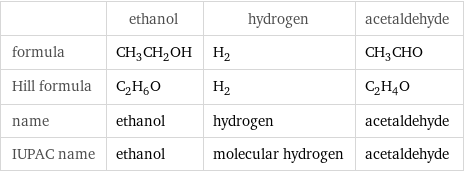
| ethanol | hydrogen | acetaldehyde formula | CH_3CH_2OH | H_2 | CH_3CHO Hill formula | C_2H_6O | H_2 | C_2H_4O name | ethanol | hydrogen | acetaldehyde IUPAC name | ethanol | molecular hydrogen | acetaldehyde
Substance properties
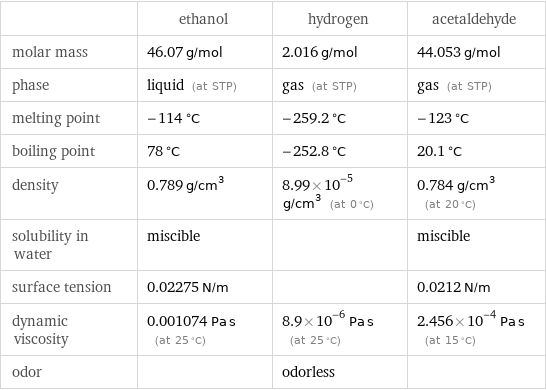
| ethanol | hydrogen | acetaldehyde molar mass | 46.07 g/mol | 2.016 g/mol | 44.053 g/mol phase | liquid (at STP) | gas (at STP) | gas (at STP) melting point | -114 °C | -259.2 °C | -123 °C boiling point | 78 °C | -252.8 °C | 20.1 °C density | 0.789 g/cm^3 | 8.99×10^-5 g/cm^3 (at 0 °C) | 0.784 g/cm^3 (at 20 °C) solubility in water | miscible | | miscible surface tension | 0.02275 N/m | | 0.0212 N/m dynamic viscosity | 0.001074 Pa s (at 25 °C) | 8.9×10^-6 Pa s (at 25 °C) | 2.456×10^-4 Pa s (at 15 °C) odor | | odorless |
Units
